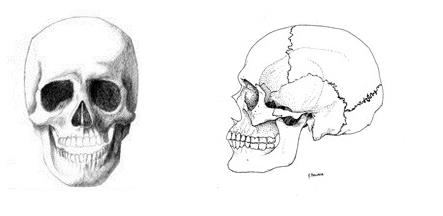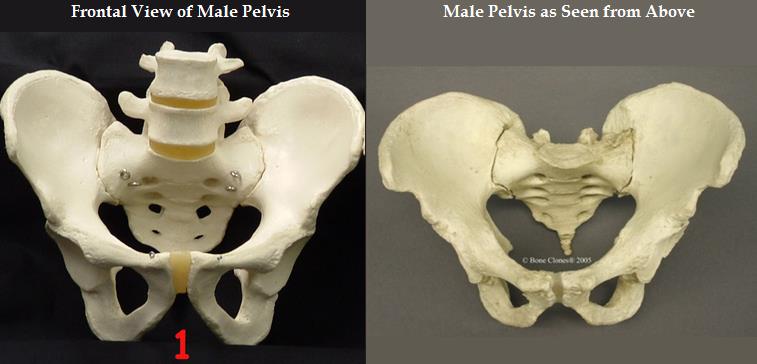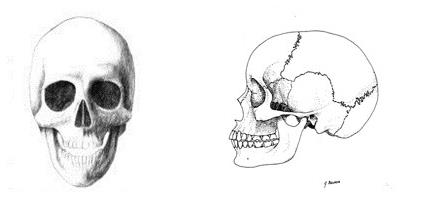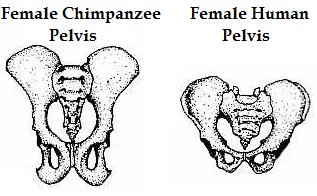If you have been reading my blogs, you would know from an early entry what a paleoanthropologist is; but in case you are new, first of all, welcome, and secondly a paleoanthropologist is one that deals with extinct hominids. These include Homo habilis all the way back to Australopithecus afarensis. Take that information with what this blog is titled, I am sure you can guess what exactly the Olduvai Gorge is. In the following I will discuss the information about our ancestors we have obtained from excavations to the first and new hominid that used tools.
First off, just where is the Olduvai Gorge? This gorge is located in the northern region of the country Tanzania, which is in Africa. I mention that it is in Africa because that plays a huge part in the findings there. The Olduvai Gorge was at first seen as something that geologists were interested in because of the fact it “is the product of both abrupt high-energy processes like volcanism and plate tectonics and the slower low-energy process of weathering and erosion operating together over millions of years. (olduvaiproject.org)” When all this was happening there were several layers of earth put down, again, over millions or years. It was not until the early 1900's when scientists began to look at these layers. The one that was doing his research there was named Hans Reck, a volcanologist from Germany. First he was there just for the earth, then he found bones from extinct animals, and what looked like those of a hominid. He would have gotten so much more if he was allowed to continue with his research, but sadly the first World War was upon him so he had to go back to his homeland. The bones they had found were placed in the Berlin Museum.
It was not until 1931 when he would be going back, but this time with help from a man by the name of Louis Leakey. Once Leaky arrived in Olduvai he realized how much this gorge held for the study of early humans. With these two men excavating they made another huge step in the future of research. They took great care to document everything they would encounter as they dug. From tools to bones, these were described and placed in chronological order. It was not until 1935 when an archaeologist joined the excavations, Louis Leakey's wife, Mary. She is the one who directed the archaeological excavations. From 1931 to 1947 they were working on ways to establish a sequence of artifacts and remains that went back 2 million years. They had found many stone axes in sediment which told them that there were humans living in these parts as much as a million years ago. Although all this new information was exciting, the most exciting thing happened years later.
The Leakey's had stayed in Africa (Louis Leakey was born in Africa), and in 1959 Mary Leakey made the most exciting discovery in the Olduvai gorge; a hominid skull. Before this discovery they would find fragment of bones, some that were in better condition that others, but when Mary found this hominid skull, it was, by far, their most exciting find. Mary named it Zinjanthropus, “Zinj” for short. Not long after, in 1960, Louis found another skull which he named H. erectus. Now there was a problem with this though. Earlier, in Asia, there was another specimine also called H. erectus. But these two skulls were very different. The one Leakey found has a brain case with thin walls while the one found in Asia has thick cranial bones. This reason is why many people at the time thought that Asia was the cradle of life, not Africa. This H. erectus is now placed, along with others found in East Africa under the specimeine Homo ergaster. Even though the Leakey's had made great steps in the history of humans, the most wonderful discovery was just around the corner for Louis Leakey.
In 1940 Louis and Mary Leakey had a child by the name of Johnathan. This is important because their child made the most exciting find in November of 1960. Found mainly at the Olduvai Gorge were many hominid fossils, amoung this vast collection of fossils Johnathan found OH 7; at the time this new discovery was named “Johnny's Child.” We now know this discovery as Homo habilis. Reason for this name is because it was, and still is, thought that this species created the vast majority of the stone tools found in gorge. H. habilis is the first known tool user, 2.4 – 1.6 millions years ago. This knowledge is the cause of the bones that were found.
The H. habilis' appearance is close to that of Australopithecus africanus, which was discovered in 1925, but the H. habilis had smaller face and teeth and no sagital crest. Because of these changes in bones, it had smaller chewing muscles, which meant there was more room for larger more complex brains. The Australopithecus had a 300-500 cm3 size skull, while the H. habilis had one a size of 510-755 cm3. In the gorge they are most likely responsible for 200 stone tools with elephant bones. Not only were they the first to make stone tools, they were the first to migrate extensively. They inhabited Africa, Asia (China, Indonesia, and India), then later, 800,000 years before present they were in Spain, France, Germany, Greece, and England.
I know that the blog is title Olduvai Gorge, but it was the Leakey's and their discoveries that added to the fame of the Olduvai Gorge. Just 27 miles from the Olduvai Gorge Mary Leakey found the Laetoli Footprints. East Africa has been the host to many history changing discoveries. If we were still under the impression that our origins were in Asia, without the knowledge Africa has given us, from stone tools to the different hominids found, who knows what kind of minds we would still have. We would most likely still believe we evolved from chimpanzees or gorillas or in search for the "missing link." From the Homo habilis, to Homo erectus, all the way back to Lucy's kind, the Australopithecus afarensis, it is just so amazing how much we know about our evolutionary ancestors, but at the same time how much we do not yet know. I mentioned that were many stone tools found, but I already wrote a blog on stone tools; if you would like to read that one here is a link to it: http://anthropologicalconcepts.weebly.com/blog/-lithic-technology
Please feel free to comment on what you thought of the blog, or other physical anthropological subjects you would like me to cover.
First off, just where is the Olduvai Gorge? This gorge is located in the northern region of the country Tanzania, which is in Africa. I mention that it is in Africa because that plays a huge part in the findings there. The Olduvai Gorge was at first seen as something that geologists were interested in because of the fact it “is the product of both abrupt high-energy processes like volcanism and plate tectonics and the slower low-energy process of weathering and erosion operating together over millions of years. (olduvaiproject.org)” When all this was happening there were several layers of earth put down, again, over millions or years. It was not until the early 1900's when scientists began to look at these layers. The one that was doing his research there was named Hans Reck, a volcanologist from Germany. First he was there just for the earth, then he found bones from extinct animals, and what looked like those of a hominid. He would have gotten so much more if he was allowed to continue with his research, but sadly the first World War was upon him so he had to go back to his homeland. The bones they had found were placed in the Berlin Museum.
It was not until 1931 when he would be going back, but this time with help from a man by the name of Louis Leakey. Once Leaky arrived in Olduvai he realized how much this gorge held for the study of early humans. With these two men excavating they made another huge step in the future of research. They took great care to document everything they would encounter as they dug. From tools to bones, these were described and placed in chronological order. It was not until 1935 when an archaeologist joined the excavations, Louis Leakey's wife, Mary. She is the one who directed the archaeological excavations. From 1931 to 1947 they were working on ways to establish a sequence of artifacts and remains that went back 2 million years. They had found many stone axes in sediment which told them that there were humans living in these parts as much as a million years ago. Although all this new information was exciting, the most exciting thing happened years later.
The Leakey's had stayed in Africa (Louis Leakey was born in Africa), and in 1959 Mary Leakey made the most exciting discovery in the Olduvai gorge; a hominid skull. Before this discovery they would find fragment of bones, some that were in better condition that others, but when Mary found this hominid skull, it was, by far, their most exciting find. Mary named it Zinjanthropus, “Zinj” for short. Not long after, in 1960, Louis found another skull which he named H. erectus. Now there was a problem with this though. Earlier, in Asia, there was another specimine also called H. erectus. But these two skulls were very different. The one Leakey found has a brain case with thin walls while the one found in Asia has thick cranial bones. This reason is why many people at the time thought that Asia was the cradle of life, not Africa. This H. erectus is now placed, along with others found in East Africa under the specimeine Homo ergaster. Even though the Leakey's had made great steps in the history of humans, the most wonderful discovery was just around the corner for Louis Leakey.
In 1940 Louis and Mary Leakey had a child by the name of Johnathan. This is important because their child made the most exciting find in November of 1960. Found mainly at the Olduvai Gorge were many hominid fossils, amoung this vast collection of fossils Johnathan found OH 7; at the time this new discovery was named “Johnny's Child.” We now know this discovery as Homo habilis. Reason for this name is because it was, and still is, thought that this species created the vast majority of the stone tools found in gorge. H. habilis is the first known tool user, 2.4 – 1.6 millions years ago. This knowledge is the cause of the bones that were found.
The H. habilis' appearance is close to that of Australopithecus africanus, which was discovered in 1925, but the H. habilis had smaller face and teeth and no sagital crest. Because of these changes in bones, it had smaller chewing muscles, which meant there was more room for larger more complex brains. The Australopithecus had a 300-500 cm3 size skull, while the H. habilis had one a size of 510-755 cm3. In the gorge they are most likely responsible for 200 stone tools with elephant bones. Not only were they the first to make stone tools, they were the first to migrate extensively. They inhabited Africa, Asia (China, Indonesia, and India), then later, 800,000 years before present they were in Spain, France, Germany, Greece, and England.
I know that the blog is title Olduvai Gorge, but it was the Leakey's and their discoveries that added to the fame of the Olduvai Gorge. Just 27 miles from the Olduvai Gorge Mary Leakey found the Laetoli Footprints. East Africa has been the host to many history changing discoveries. If we were still under the impression that our origins were in Asia, without the knowledge Africa has given us, from stone tools to the different hominids found, who knows what kind of minds we would still have. We would most likely still believe we evolved from chimpanzees or gorillas or in search for the "missing link." From the Homo habilis, to Homo erectus, all the way back to Lucy's kind, the Australopithecus afarensis, it is just so amazing how much we know about our evolutionary ancestors, but at the same time how much we do not yet know. I mentioned that were many stone tools found, but I already wrote a blog on stone tools; if you would like to read that one here is a link to it: http://anthropologicalconcepts.weebly.com/blog/-lithic-technology
Please feel free to comment on what you thought of the blog, or other physical anthropological subjects you would like me to cover.





 RSS Feed
RSS Feed
